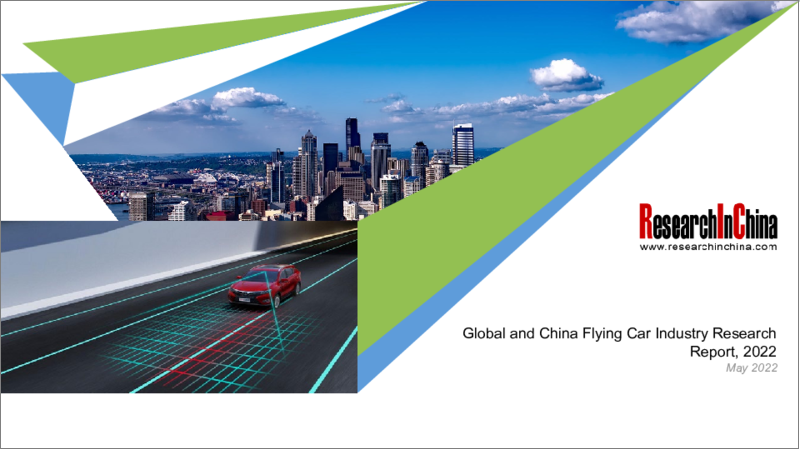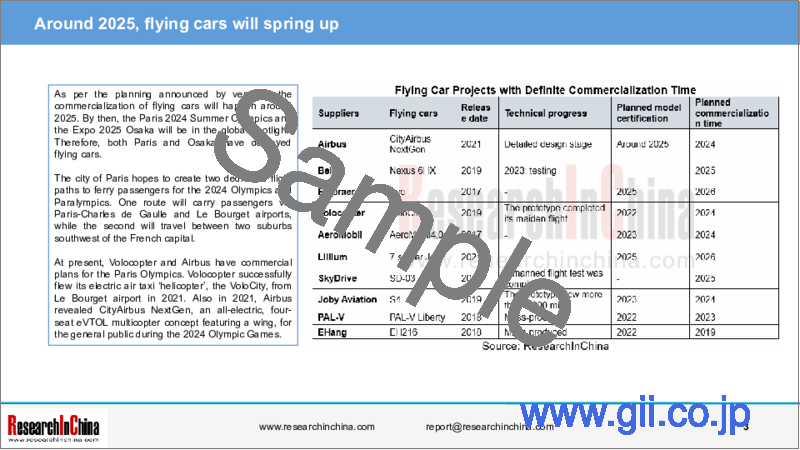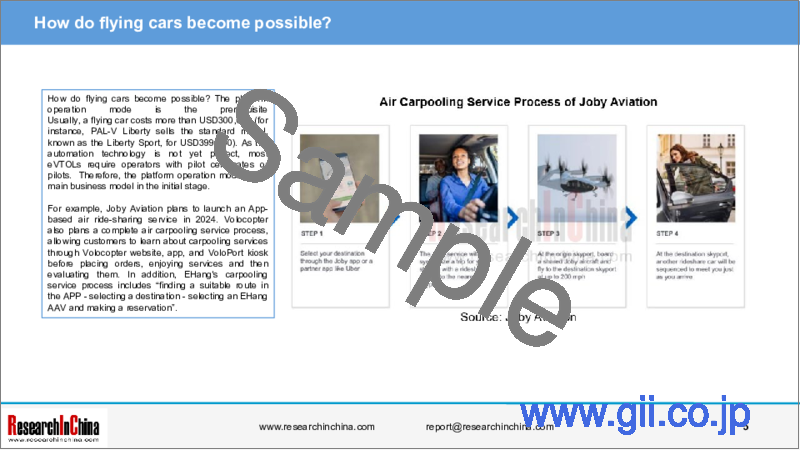|
|
市場調査レポート
商品コード
1090724
世界と中国のフライングカー産業の分析 (2022年)Global and China Flying Car Industry Research Report, 2022 |
||||||
| 世界と中国のフライングカー産業の分析 (2022年) |
|
出版日: 2022年05月12日
発行: ResearchInChina
ページ情報: 英文 155 Pages
納期: 即日から翌営業日
|
- 全表示
- 概要
- 目次
フライングカー (Flying Car:空飛ぶクルマ) とは、電動垂直離着陸 (eVTOL) 機能を有する、貨物・人員輸送用の低高度のインテリジェント自動運転ツールです。飛行技術別に見ると、固定翼型・マルチローター型・複合翼型・傾斜翼型の4種類があります。現在はマルチローター型が最も利用されていますが、今後、路線網の整備や長距離輸送の需要増加が進めば、航続距離が長く、巡航速度が速い複合翼や傾斜翼が徐々に主流になると思われます。
ベンダーが発表している計画では、フライングカーの実用化は2025年頃とされています。その頃には、2024年のパリ夏季オリンピックや2025年の大阪万博が世界的に注目されるようになります。そのため、パリも大阪もフライングカーを配備しています。
当レポートでは、世界と中国のフライングカー産業について分析し、製品の概要や現在の開発状況、世界全体および中国国内の市場環境と動向見通し、主要サプライヤー・OEMのプロファイルとフライングカー事業の展開状況、といった情報を取りまとめてお届けいたします。
目次
第1章 フライングカーの概略
- 意味
- フライングカーの分類
- 開発の歴史
- 用途
- 課題
- 技術構成
- 自律型フライングカー技術のレベル
- 開発動向
第2章 世界と中国のフライングカー市場
- 市場規模
- 法規制:中国
- 法規制:欧州・米国
- 日本のフライングカー開発計画:全国レベル
- 日本のフライングカー開発計画:地方レベル
- 韓国のフライングカー開発計画
- 欧州・米国のフライングカー開発計画
第3章 フライングカーのサプライヤー
- 概要と分析
- Boeing
- Airbus
- Bell
- Muyu Aero
- Embraer
- AVIC
- Volocopter
- AeroMobil
- Lilium
- SkyDrive
- Joby Aviation
- PAL-V
- Kitty Hawk
- Opener
- EHang
第4章 フライングカーを展開しているOEM
- 概要と分析
- Geely
- Xpeng
- Hyundai
- GM
- Aston Martin
- Porsche
- Toyota
- Honda
- Suzuki
- Daimler
ResearchInChina has released "Global and China Flying Car Industry Research Report, 2022".
A flying car is a three-dimensional vehicle. Broadly speaking, it is a low-altitude intelligent autonomous transportation tool carrying cargo or people, namely electric vertical take-off and landing (eVTOL). It features electric vertical take-off and landing, intelligent autonomous driving, amphibious transport and so on.
Multi-rotor configuration is the current mainstream
The technical configurations of flying cars mainly include four types: fixed wings, multi-rotors, composite wings and tilting wings. Among them, the most traditional fixed wings are rarely used due to the inability to take off and land vertically and hover. On the market, the most used multi-rotors take off and land vertically, hover precisely, are simple to operate with little technical difficulty, and land quickly. But, they are only suitable for short-distance transportation because of a short range.
In the future, with the improvement of the route network and the growth of long-distance transportation demand, composite wings and tilting wings with longer range and faster cruising speed will gradually become the mainstream.
Around 2025, flying cars will spring up
As per the planning announced by vendors, the commercialization of flying cars will happen around 2025. By then, the Paris 2024 Summer Olympics and the Expo 2025 Osaka will be in the global spotlight. Therefore, both Paris and Osaka have deployed flying cars.
The city of Paris hopes to create two dedicated flight paths to ferry passengers for the 2024 Olympics and Paralympics. One route will carry passengers via Paris-Charles de Gaulle and Le Bourget airports, while the second will travel between two suburbs southwest of the French capital.
At present, Volocopter and Airbus have commercial plans for the Paris Olympics. Volocopter successfully flew its electric air taxi 'helicopter', the VoloCity, from Le Bourget airport in 2021. Also in 2021, Airbus revealed CityAirbus NextGen, an all-electric, four-seat eVTOL multicopter concept featuring a wing, for the general public during the 2024 Olympic Games.
Osaka, Japan has made a very detailed roadmap for the commercialization of flying cars: regular flights will be opened in 2025, routes will be added in 2030, and aircrafts will be larger and diversified in 2035. SkyDrive and Joby Aviation have planned to provide commercial services during the Expo 2025 Osaka (in February 2022, ANA HOLDINGS, INC. and Joby Aviation announced they were forming a partnership that will see Japan's largest airline join with Joby to bring aerial ridesharing services to cities and communities across Japan. Toyota Motor Corporation also joined the partnership).
How do flying cars become possible? The platform operation mode is the prerequisite
Usually, a flying car costs more than USD300,000 (for instance, PAL-V Liberty sells the standard model, known as the Liberty Sport, for USD399,000). As the automation technology is not yet perfect, most eVTOLs require operators with pilot certificates or pilots. Therefore, the platform operation mode is the main business model in the initial stage.
For example, Joby Aviation plans to launch an App-based air ride-sharing service in 2024. Volocopter also plans a complete air carpooling service process, allowing customers to learn about carpooling services through Volocopter website, app, and VoloPort kiosk before placing orders, enjoying services and then evaluating them. In addition, EHang's carpooling service process includes "finding a suitable route in the APP - selecting a destination - selecting an EHang AAV and making a reservation".
Table of Contents
1. Introduction to Flying Cars
- 1.1 Definition
- 1.2 Classification of Flying Cars
- 1.3 Development History
- 1.4 Application
- 1.5 Challenges
- 1.6 Technical Configuration
- 1.7 Levels of Autonomous Flying Car Technology
- 1.8 Development Trends
2. Global and Chinese Flying Car Market
- 2.1 Market Size
- 2.2 Laws and Regulations - China
- 2.3 Laws and Regulations - Europe and America
- 2.4 Japan's Flying Car Development Planning - National Level
- 2.4.1 Japan's Flying Car Development Planning - Local Level
- 2.5 South Korea's Flying Car Development Planning
- 2.6 Flying Car Development Planning in Europe and America
3. Flying Car Suppliers
- 3.1 Overview and Analysis
- 3.2 Boeing
- 3.2.1 Profile
- 3.2.2 Development History of Flying Cars
- 3.2.3 Introduction to Flying Cars
- 3.2.4 Comparison of PAV and CAV Parameters of Flying Car Prototypes
- 3.3 Airbus
- 3.3.1 Profile
- 3.3.2 Development History of Flying Car Projects
- 3.3.3 Introduction to Flying Cars
- 3.3.4 Parameters of Flying Car
- 3.3.5 Cooperation in Urban Air Mobility (UAM)
- 3.4 Bell
- 3.4.1 Profile
- 3.4.2 Introduction to Flying Cars
- 3.4.3 Parameter Comparison of Air Taxis
- 3.4.4 Cooperation and Development Plan in Air Mobility
- 3.5 Muyu Aero
- 3.5.1 Profile
- 3.5.2 Introduction to Flying Cars
- 3.5.3 Parameters of Flying Cars
- 3.6 Embraer
- 3.6.1 Profile
- 3.6.2 Development History and Planning of Flying Cars
- 3.6.3 Parameters of Flying Cars
- 3.6.4 Major Customers
- 3.6.5 Cooperation
- 3.7 AVIC
- 3.7.1 Profile
- 3.8 Volocopter
- 3.8.1 Profile
- 3.8.2 Financing
- 3.8.3 Development History of Flying Cars
- 3.8.4 Introduction to Flying Cars
- 3.3.5 Parameters, Layout and Planning of Flying Cars
- 3.8.6 Commercialization Operation Plan of Flying Cars
- 3.8.7 Air Taxi Service Process
- 3.8.8 eVTOL industry chain
- 3.8.9 Cooperation
- 3.9 AeroMobil
- 3.9.1 Profile
- 3.9.2 Financing and Development History
- 3.9.3 Introduction to Flying Cars
- 3.9.4 Parameters of Flying Cars
- 3.9.5 Commercialization Cooperation Dynamics and Planning
- 3.10 Lilium
- 3.10.1 Profile
- 3.10.2 Financing
- 3.10.3 Development History and Planning of Flying Cars
- 3.10.4 Commercial Operation Plan of Flying Cars
- 3.10.5 Operation Network Layout of Flying Cars
- 3.10.6 Introduction of 7-seater Flying Cars
- 3.10.7 Parameters of Flying Cars
- 3.11 SkyDrive
- 3.11.1 Profile
- 3.11.2 Financing
- 3.11.3 Development History
- 3.11.4 Introduction to Flying Cars
- 3.11.5 Parameters of Flying Cars
- 3.11.6 Commercialization Roadmap and Cooperation
- 3.11.7 Partners
- 3.12 Joby Aviation
- 3.12.1 Profile
- 3.12.2 Financing
- 3.12.3 Development History
- 3.12.4 Production, Certification and Operation Planning of Flying Cars
- 3.12.5 Skyport Network Planning and Air Carpooling Service Charges
- 3.12.6 Air Carpooling Service Process
- 3.12.7 Introduction to S4
- 3.3.8 Parameters of S4
- 3.12.9 Cooperation Dynamics
- 3.13 PAL-V
- 3.13.1 Profile
- 3.13.2 Development History and Planning of Flying Cars
- 3.13.3 Introduction to Liberty
- 3.13.4 Parameters of Liberty
- 3.14 Kitty Hawk
- 3.14.1 Profile
- 3.14.2 Development History and Planning of Flying Cars
- 3.14.3 Flying Car Projects
- 3.3.4 Parameters of Heaviside H2
- 3.15 Opener
- 3.15.1 Profile
- 3.15.2 Development History and Planning of Flying Cars
- 3.15.3 Introduction to BlackFly
- 3.15.4 Parameters of BlackFly
- 3.16 EHang
- 3.16.1 Profile
- 3.16.2 Financing
- 3.16.3 Main business
- 3.16.4 Development, Certification and Planning of Flying Cars
- 3.16.5 Introduction to Flying Cars
- 3.16.6 Parameters of Autonomous Aerial Vehicles
- 3.16.7 Commercial Operation of Flying Cars
- 3.16.8 "100 Air Traffic Routes" Plan
- 3.16.9 Capacity Eexpansion and Major Customers
- 3.16.10 Urban Air Mobility Ecosystem Layout
4. OEMs Deploying Flying Cars
- 4.1 Overview and Analysis
- 4.2 Geely
- 4.2.1 Profile
- 4.2.2 Development History of Transition
- 4.2.3 Introduction to Flying Cars
- 3.3.4 Parameters of Flying Cars
- 4.2.5 Dynamics
- 4.3 Xpeng
- 4.3.1 Profile
- 4.3.2 R&D and Flight Test Base Layout
- 4.3.3 Development History and Planning
- 4.3.4 Introduction to Flying Cars
- 3.3.5 Parameters of Flying Cars
- 4.3.6 Dynamics
- 4.4 Hyundai
- 4.4.1 Profile
- 4.4.2 Introduction to Flying Cars and Parameters
- 4.4.3 Future Mobility Vision
- 4.4.4 Dynamics
- 4.5 GM
- 4.5.1 Flying Car Layout Dynamics
- 4.6 Aston Martin
- 4.6.1 Flying Car Layout Dynamics
- 4.7 Porsche
- 4.7.1 Flying Car Layout Dynamics
- 4.8 Toyota
- 4.8.1 Flying Car Layout Dynamics
- 4.9 Honda
- 4.9.1 Flying Car Layout Dynamics
- 4.9.2 Development Capabilities of Flying Cars
- 4.9.3 Future Mobility Ecosystem Vision
- 4.10 Suzuki
- 4.10.1 Flying Car Layout Dynamics
- 4.11 Daimler
- 4.11.1 Flying Car Layout Dynamics




